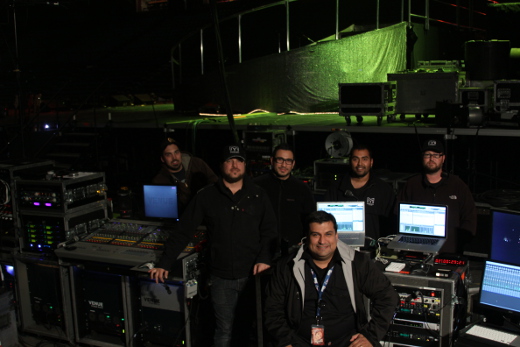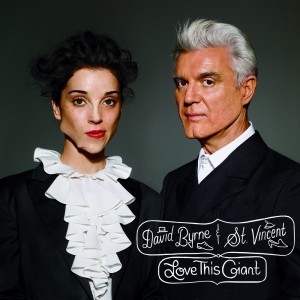Learning To Fly II — The Real Guide to Being a Monitor Engineer, with Javier Alcaraz
It seems like everyone wants to be at the front of the house.
Inside the gates, behind the flashy console, in the middle of the crowd, the engineer stands mixing the show for the fans. Audience members chat about him as they exit (though they might not know it): “Wow, that show sounded amazing tonight!” is just another way of saying, “Nice job, FOH guy.” (Conversely, “It seemed like the vocals weren’t loud enough,” can be translated into “Could have done better, FOH guy.”)
As the FOH engineer is busy sending signal to the house PA speakers, mixing music for the audience to dance (or to sway, shake, shimmy, grind or mosh) to, the monitor engineer is hard at work, out of the spotlight, tucked away on the side of the stage. Rather than creating a single music mix for the audience, the MON engineer contrives numerous stage mixes—creating varying balances for each performer.
While these two positions have a lot in common, the jobs are not simply interchangeable. The MON engineer position is a world of multitasking and skill; not merely an extension of the FOH engineer position. The responsibilities, workflow and skill sets of the FOH and MON engineers differ widely.
If you are presented with an opportunity to move from FOH to MON engineer, it will not be easy. You will need some help. We will need a master to get you up to speed.
Javier Alcaraz has been mixing live sound since 1996. He’s worked as both a front-of-house and monitor engineer, and as a tour and/or production manager for huge, worldwide concert series. His resumé boasts stints with renowned musical acts such as Kenny Loggins, Collective Soul, Elvis Costello, David Cook, Selena Gomez and Demi Lovato. SonicScoop caught up with Alcaraz following David Byrne’s & St. Vincent’s (Annie Clark) Love This Giant tour (September 2012 – September 2013), on which Alcaraz worked as a monitor engineer.
Could you give me a little play-by-play on your activities/preparation leading up to a gig?
Advance:
The first thing is advance.
Make sure you know the artist, their spec requirements, and the venue or venues that you will be playing. Let’s say that you’re prepping for a tour: You would first want to discuss the stage layout with the production manager or tour manager and figure out the physical layout of the stage.
Next is to talk to the band (though sometimes this is not possible, depending on schedule or other factors); discuss the band’s needs and figure out what gear you will need—console type, in-ear monitor or wedges, microphone requirements, etc. Discuss and review the input list with the FOH engineer and come up with a plan.
Setup:
Hopefully you have had some rehearsal time and you are on your way to a good foundation with your mix. During your setup, you must consider the whole show — safety, artist sightlines, egress, footprint — in conjunction of other departments (lights, video, etc.).
You must be able to do your job and so does everyone else: You may have backline techs on your side of stage, you may have to have sightlines to various positions on stage, you may have to make movements on stage yourself. Know your show, and play nice with others. Don’t compromise yourself to a point that you cannot adequately do your job, but know that you are not the only department on the deck.
During the show?
There’s only one thing you need to do: Pay attention. Don’t take your eyes or ears off the stage.
All of your hard work and preparation is for the 90 minutes or so that your band is on stage. Look for signs or hints of monitor needs, and try to address them prior to them being an issue (this is usually built over time through the artist/engineer relationship, but you can establish it early on by just paying attention). A famous singer-songwriter once instructed me, “Do not take your eyes off of me.” Enough said.
You recently ran the monitors for the Love This Giant tour with David Byrne and St. Vincent. Can you give me an example of the onstage communication you had with Byrne and (Annie) Clark?
David Byrne wore a wireless headset microphone. If there was ever an issue, he would say, “Hey Javier, can you do this…” out in the PA. It was actually pretty funny.
As for Annie, I’ve known her since she was 14 and we’ve developed a sign language over years and years now. She knows I’m watching all the time. She doesn’t even have to look over at me. She’ll be singing with both hands on the microphone, eyes closed, doing her thing. Then she will literally take her index finger, with both hands still on the microphone, and point it up. Without looking at me, that finger will stay up until I make the appropriate change, and then her finger will go down. She’ll point over to me and, with her hand, she’ll put up two fingers, five fingers, no fingers, and then finally point down—2-5-0-down—which means she wants me to bring down 250 Hz.
How did you become a touring MON engineer?
I first started as a systems tech and FOH engineer. It was back in the day of analogue, so the learning curve from FOH to MON engineer wasn’t too bad. I was just managing mixes and making sure I was being organized with the console layout. There were a lot of concepts that took time to grasp.
What, if any, learning curves did you face in the process?
In the circumstances where there are wedges on stage, feedback is always your nemesis. It’s that gain before feedback that you’re constantly riding.
There wasn’t an “ah-ha” moment for me. It was really just learning frequencies. You can’t do the job well without learning frequencies. You have to be able to hear that it’s 250 Hz, that it’s 3k—I don’t care how much book time you’ve had.
Then there’s people management, people skills and being able to take 10 orders at once, assess them in your mind, know which are the most important ones to get out, and then process them in order. You need to be able to get things up and running as fast as possible.
The real learning curve did not come until I had to switch to digital. Things got interesting then. Luckily, I knew what I wanted to accomplish with my mix, it was just a matter of how I get there now.
Could you share any lessons that you learned early on?
Early on, I was shown a technique by one particular monitor engineer who would set all of his sends right away and base the levels on ratios. Since the drummer wanted the kick drum at its loudest (100 percent), he would set the output for that channel on the drummer’s mix to unity.
The bass player also wanted the kick drum at 100 percent, so the kick drum channel on the bass player’s mix was set to unity as well. The guitar player only wanted to hear the kick drum at 50 percent, so for his mix, the output for that channel was set accordingly. The engineer laid out each of his mix outputs.
Once all of the outputs for that channel were set, he would have someone go up to the instrument so he could adjust the preamp accordingly. At that point, it didn’t just come up in one mix; it came up across the whole stage in the right relationship. It was real backwards thinking for me. Since then, I’ve always mixed that way. I work backwards in a weird way.
What do you think less-experienced MON engineers typically have the most trouble with?
I think patience is key. I see a lot of young engineers getting easily frustrated. I’ve seen FOH engineers or systems techs being put in the MON position by their company and they end up not being comfortable with their surroundings.
The MON position is a challenging position, and if you do not want to be there, it can be hell. This comes out in an engineer’s demeanor and attitude. It reflects in their performance and patience with their responsibilities. If you are not comfortable in that position, do not do it!
The other aspect I see is communication with the artist/band. Being a monitor engineer, you must know the scope of your job. It is important to support and communicate with your artist. What you might want to hear may not be what the artist on stage wants to hear. It’s important to put your opinion aside and do what it takes to make your artist comfortable.
Unlike FOH, it is not necessarily about the “mix,” it is about monitoring. The artists need to hear certain things at certain levels and that may not be musical at times, but that is not what it is about.
Imagine you only had a few weeks to get someone with very little experience up to speed on being an effective MON engineer. What would the training include?
Frequency management for IEM and RF (radio-frequency) mics. On my current tour, I have 14 wireless units and 12 channels of RF mics. Besides that, we have wireless guitars, etc. So a big part of our day is frequency management, knowing the various spectrums and how they interact. Almost all bands I work with are on wireless in-ears, so this is a must.
Next would be gain stage (unity gain). This is something we are all taught, hopefully early, in the learning process, and it is not until you understand and respect unity gain that you’re able to change the rules that suit your needs.
If you could send that inexperienced engineer out for their first MON gig with a small cheat sheet of information, what would be on it?
- Learn everyone’s name (do not just go, “Hey bass player”).
- Input list/stage plot for the band.
- If it is digital, which most likely it would be, bring a file that was set up offline to load in the console upon arrival. Things will change, but at least you have a map of how things are situated on the console and on stage. Trying to program and set up at the same time is not ideal. In fact, in my opinion, it shows that you have not done your homework. Be prepared. Even if it is a generic file, set up for a generic band for both ears and wedges—have it ready to go.
And what would you advise that engineer to bring in his/her “tool belt” to the gig?
- A Leatherman
- A flashlight with fresh and extra batteries (Don’t use your iPhone as a flashlight—that looks like “amateur hour.”)
- A headlamp
- Work gloves
- Precision screwdrivers
- Large alcohol wipes
- Scissors
- Tape—gaff, electrical, water proof bandage tape (for ear cables)
- Headphones, headphone extension cables, backup generic earbuds
- An assortment of adaptors
Jon Lurie is an audio engineer and musician living in Sunnyside, Queens. His favorite Beatles album is Abbey Road. Follow him on the interweb @jon_lurie.
Please note: When you buy products through links on this page, we may earn an affiliate commission.










JimRosebrook
January 14, 2014 at 12:50 pm (10 years ago)Lots of practical info in this article… fledging sound engineers MUST read.
JLurie
January 14, 2014 at 2:59 pm (10 years ago)Anything to add to the tool belt, Jim?